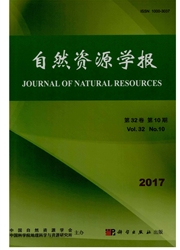

 中文摘要:
中文摘要:
利用Penman-Monteith模型及1957—2014年长三角地区43个气象站点逐日降水、气温、风速、日照时数及空气相对湿度实测数据,对参考作物蒸散量、地表湿润指数和极端干旱/湿润事件进行了计算和统计。运用线性回归、Trend-free pre-whitening(TFPW)Mann-Kendall趋势检验、Morlet小波分析等方法,分析了研究区地表湿润指数及极端干湿事件的时空分布特征。结果显示:1)近58 a长三角地区年及季节平均湿润指数在空间上呈南高北低分布格局;2)年湿润指数呈波动下降趋势,变化倾向率为-0.021/10 a,气候趋于干旱化。湿润期集中在20世纪80、90年代。突变年为2003年,并存在多个振荡周期。四季中,春秋季气候趋于干旱化,冬夏季反之。年际湿润指数变异系数和变化趋势存在明显的空间差异;3)年极端干旱事件发生频率呈波动上升趋势,年极端湿润事件则呈现微弱的下降趋势,均存在空间差异。
 英文摘要:
英文摘要:
Based on the Penman-Monteith Model and the daily meteorological data of precipitation, temperature, wind speed, sunshine duration and relative air humidity at 43 stations in Yangtze River Delta from 1957 to 2014, reference crop evapotranspiration, surface humidity index and extreme drought/wet events were detected and counted. The spatial and temporal variation of humidity index and extreme drought/wet events were analyzed using linear regression, TFPW-MK trend test and Morlet wavelet. The results indicated: 1) Annual and seasonal mean humidity indexes showed similar distribution patterns in recent 58 year in Yangtze River Delta except in summer that higher values distributed in the south and lower values distributed in the north, which were mainly influenced by latitude, distance from the sea,topographic conditions, and general atmospheric circulation. In summer, the low values of relative humidity index emerged along the axis of"North-central of Anhui-South-central of Jiangsu-North of Zhejiang-Shanghai". 2) The climate showed the tendency of turning arid that the annual humidity index decreased at the rate of-0.021/10 a. 1980 s and 1990 s are humid period. The sudden change of annual relative humidity occurred in 2003 according to TFPWMK abrupt change test, and there were several oscillation periods of annual relative humidity according to wavelet analysis, such as 12-18-year period from 1957 to 1990, 8-10-year period since 1977. At seasonal scale, the climate in spring and autumn turned dry and the climate in winter and summer turned humid. The mutational years of spring, autumn and winter were 1999, 1988 and 1985 respectively. Moreover, there were also several oscillation periods at seasonal scale. The change characteristics were mainly influenced by the variation of precipitation, evapotranspiration, Southern Oscillation and subtropical high over the western Pacific. Spatially, the aridification mainly happened in southeast, east and part of the west regions, while the humidification mainly emerged
 同期刊论文项目
同期刊论文项目
 同项目期刊论文
同项目期刊论文
 期刊信息
期刊信息
